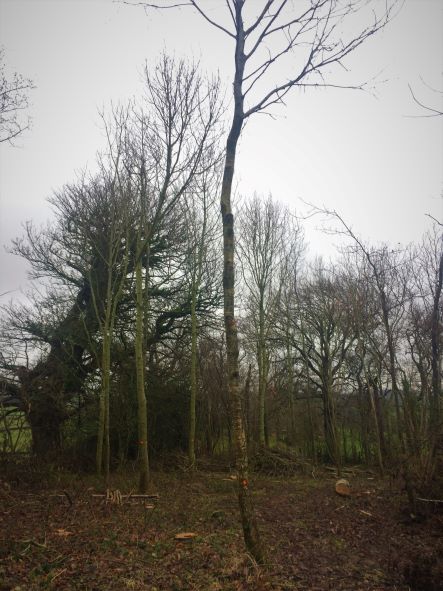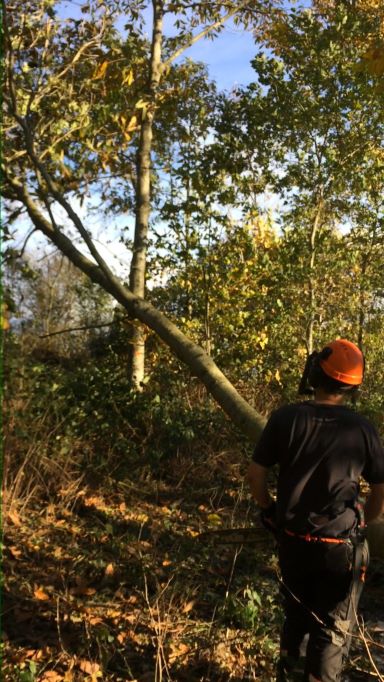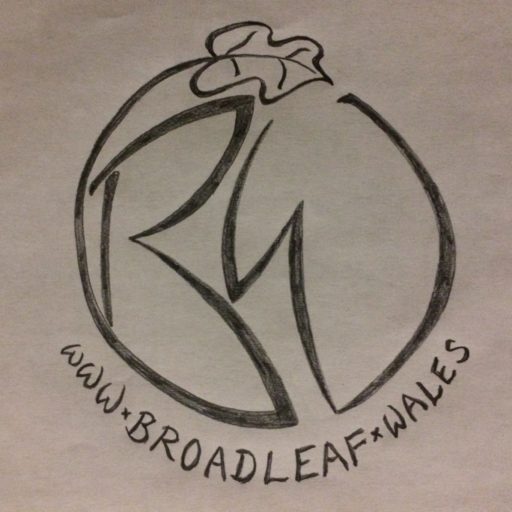This season at Bron Haul we have been thinning one of our older blocks, (around 25 years old). Having passed my chainsaw ticket for felling trees upto bar length with Keith Webber, I have been putting my directional felling to the test. With the continuous cover forestry mindset, we thin selectively. Before we start the saws we go through the woods tagging all of the trees we think will yield the best timber so that we can retain them. At this point in the age of the woodland, we are choosing the final stock of the first generation and it’s important that we choose good trees and look after them.
Choosing Trees to Favour

Marked oak tree post-thinning
What we value most in timber trees is mostly vigour (diameter size), straightness of the stem, quality of pruning (for quality timber)and also well-balanced crowns for growth. Investing in these trees by letting them grow we must also ensure we choose trees that are healthy, we look at them carefully for damage or signs of disease, as well as seeing how well the tree has healed from pruning.
While tagging trees we keep into consideration much more than just the tree itself, we try to ensure that the species diversity is maintained and that our selected trees are also the right distance apart for our intended stocking density. For instance, while the oak trees might be smaller and are often even shaded out, choosing to favour these trees will over time produce very valuable timber and keep the species present in the woods structure.
Creating Age Diversity
Once we start thinning, we remove the trees that would impede on the growth of our favoured trees. By taking them out, the timber trees have space in the canopy and will grow. The open space in the canopy also allows more light to the forest floor giving life to the woodland ground flora as well as the next generation of growth. This next generation is important to continuous cover forestry as it is hoped that coppice regrowth and self-seeded trees will replace the older trees in the woodland.
While felling it is easy to damage other trees which can cause issues to the health and the future of that tree. To avoid this it’s imperative that technical cuts and directional felling is done well (in both of which I feel I have improved).

Accurate directional fell between favoured oak trees
Product range from thinnings
With the results of our thinning we have managed to make some different products. Most has been firewood quality, which is being transported to a firewood merchant. Because of the transportation it is important that we use a standard length and get all of the wood to an accessible area. We took the tractor through the access routes that we had cleared and managed to get the timber to a roadside stack which is meeting our expected volume. As well as this, the smaller diameter timber will be good as firewood for us to use ourselves.

25 tonnes of cordwood stacked at roadside
Other than firewood we’ve also managed to get materials to make sweet chestnut posts which can and are being used on different projects. Wherever we could find a log of good size and quality, we keep it aside for sawing or cleaving, proving itself already as valuable timber for different products.
Amongst the standard trees there are multi-stemmed hazel stools that often get in the way, though some of the materials collected are good enough to make baskets, hedging stakes and other hazel crafts.

Wind-blow during storm Anwen
Sadly, we suffered some wind-blow during storm Anwen, and I will look forward to taking my wind-blow and felling over 380mm units in January with trainer, Alun Jones, to be able to deal with these.
